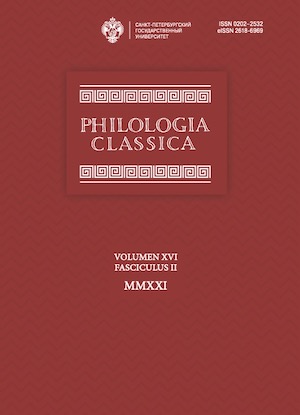Eumolpus’ Poetics (Petr. Sat. 118): Problems of Interpretation and Train of Thought
DOI:
https://doi.org/10.21638/spbu20.2021.206Аннотация
The article aims to restore the train of thought in Petr. Sat. 118. 3–5. In 118. 3, the manuscript reading sanitatem (instead of the emendation vanitatem) is to be retained and taken not as hinting at the lack of poetic ecstasy, but as ‘stylistic simplicity’ after Pavlova 2017. The adversative ceterum does not imply that poetry is the polar opposite of rhetoric, but stresses that contrary to the expectations of poeticizing orators, true poetry is hard toil. The first neque-clause does not imply contrast with rhetoric, but calls for a copious style (in particular, copious sententiae). The second neque-clause implies that poetry must absorb an immense literary tradition in order to attain a copious language. Thus, the two coordinate neque-clauses in 118. 3 are paired as requiring copiousness (a) in style and (b) in language. In the next two sentences, (a) and (b) are specified in chiastic order: (b) the borrowed diction must be elevated (118. 4); (a) the sententiae (as the primary stylistic ornament) must be integrated into the texture of the poem (118. 5). The idea that absorbing literary tradition must enrich poetic language may be paralleled in Hor. Epist. 2. 2. 115–118. Sententiae are regarded as an essential constituent of poetic style, despite the ironic remark on sententiolae vibrantes in 118. 2.
Ключевые слова:
Petronius, Satyricon, literary criticism in antiquity, poetry and rhetoric
Скачивания
Библиографические ссылки
Загрузки
Опубликован
Как цитировать
Выпуск
Раздел
Лицензия
Статьи журнала «Philologia Classica» находятся в открытом доступе и распространяются в соответствии с условиями Лицензионного Договора с Санкт-Петербургским государственным университетом, который бесплатно предоставляет авторам неограниченное распространение и самостоятельное архивирование.






